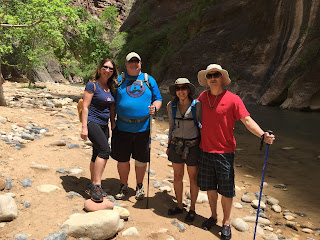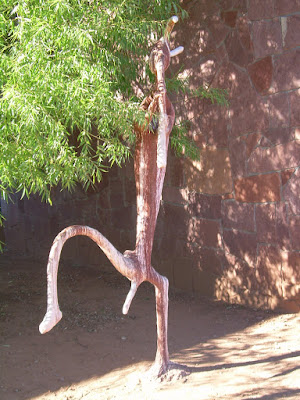It had been about ten years since I last visited the Grand Canyon where I had once lived for fifteen years, between 1978-1992, and I was shocked by the changes.
Wild fires had mowed down huge swaths of the North Rim of Grand Canyon National Park and the North Kaibab Forest. And I felt like I was at least partly to blame.
I helped shut down the logging in 1992. You can read all about it in my popular memoir "The Canyon Chronicles". I have no regrets that I helped expose the excessive harvesting and illegal logging activities that laid waste to the ancient forest. But as so often happens in America, we swing between extremes. There is rarely any middle ground. We either cut the hell out of the forest, or we don't cut anything. But the world of nature can not flourish on 4-year political cycles.
After the dust had settled from the federal court case, all logging ceased on the North Kaibab. And while it was only supposed to be temporary, the local environmental groups kept stringing things out, the mill in Fredonia soon shut down and moved to South America, and the nearest sawmill in Panguitch, Utah could not afford to log a forest over a hundred miles away. So the economics of logging ensured that the court action became permanent. Even to this day.
The enviros rejoiced. They hated all of the logging.
I predicted right after Kaibab Industries was found guilty of stealing wood that if the Forest Service stopped harvesting timber altogether, the forest would just become a matchbox waiting to go up in flames. But the enviros said it should just be left alone to evolve naturally. Mother Nature could take care of herself. And they got their wish.
When you stop logging a forest like the North Kaibab that has been extensively logged for a long period of time, and remove controlled fire from the equation, the trees continue to die from old age and disease, and then they fall over on one another, creating the perfect conditions for a hot burn. Meaning that when a fire comes roaring through the old forest it has lots of fuel to play with. And that fuel burns really hot and climbs into the canopies of the living trees. In a managed forest, there isn't much dead woody debris on the ground, so the fire rolls through at about ten miles an hour, singeing the trees and then moving on in a matter of minutes. Ponderosa pine have actually evolved so that fires trigger the trees to throw out seeds. But where there are lots of down trees and brush, the fire burns every living thing.
On June 8, 2006 a lightning strike ignited the Warm Fire that barreled across the North Kaibab and wiped out most of the forest between Jacob Lake and the North Rim – more than thirty miles of charred woodland. I didn't even recognize the place anymore.
Wildlife biologists are always quick to point out that fire is a good thing. It burns off the dead woody debris and opens up the forest. The seeds of diversity are then spread far and wide. And that's all fine and dandy. But what I saw on the Kaibab was a complete disaster. The big yellow pines have been replaced by aspens that grow like weeds and completely take over an area, out-competing the pines, spruce, and fir. They are poping up as thick as the fur on a dog's back and in the future people will drive through a forest of pretty little aspens, all the same size, like rows of corn, and they will marvel at their beauty. But for me, I will forever remember the primeval evergreen forest that had survived wild fires for thousands of years but eventually fell victim to knee-jerk environmental nonsense.
But the thing that has really changed the face of the entire Colorado Plateau isn't natural. It is tourism. And I had a hand in that one too.
We hippie redneck enviros who worked for the Forest Servive and the Park Service back in the 70s and 80s, used to fight against all of the hungry extractive industries – logging, mining, grazing – that were out of control and chewing up the landscape. We constantly preached the gospel of recreation. We argued that for the very first time in the history of the American West, tourism could bring about a truly sustainable economy. Harvest touron dollars, not the limited natural resources. And guess what? We got our wish. They totally did it.
Every park we visited was packed to the gills, often resembling a major sporting event or a rock concert. And if managed properly, it will undoubtedly pump millions of dollars into the local economies for many years to come without too much harm to the golden goose. And unlike mining or logging, you can't use it all up. It is sustainable. But the size and scope of this kick-out-the-blocks, industrial strength tourism that brings happy visitors from all around the world in bus after bus to our national parks throughout the Southwest, takes a bit of getting used to when there used to be pretty much nothing except the parks themselves and odd little roadside services and attractions.
Little towns like Springdale, on the west side of Zion, are now bustling with hotels, gift shops, and trendy restaurants.
The area on the northern outskirts of Bryce, where Ruby's Inn used to be the only business has grown into a town – with a traffic light no less. In fact, it was incorporated as a full-fledged town –
The lines of cars at the entrance stations into the big parks like Zion and Bryce can stretch for miles.
And the Navajos have fully embraced this tourist bonanza. All across The Rez, business is booming. Where once you could just go for a hike in some isolated Canyon in Navajoland, there are now locked gates and they charge admission. Antelope Canyon, near Lake Powell, looked like a Disneyland ride. The crowds walking up the sandy ridge overlooking Horseshoe Bend near Page reminded me of the gallery at the U.S. Open golf tournament. In places like Monument Valley and Lake Powell, the roads were teeming with canopied, open-air wagons filled with tourons being pulled by shiny new pickups with smiling Navajo guides at the wheel. Ka-CHING!
Interestingly, the traditional Mormon towns like Orderville and Hatch, sitting quietly between Zion and Bryce along Highway 89 in Long Valley, are still pretty much the same. Brigham Young's vision of creating a buffer land between the Mormons and the Gentiles is still working for the most part. And tourism has barely scraped the surface.
Lasting Impressions
Many people say they enjoyZion more than Grand
Canyon . That's kind of crazy because Zion would fit into one of Grand Canyon's many side canyons. It's like a very pretty toe nail on the world's grandest elephant. I think the reason people prefer Zion so much is because you can drive through the bottom
and look up at the towering canyon walls without any effort; whereas at Grand Canyon you can only stand on the rim and look down
into the magnificent interior, unless, of course, you are willing to endure a very long and grueling hike. And most folks simply don't have the time. They are off to see the next big attraction, like Shamu at the whale jail in San Diego before their flight back home.
Many people say they enjoy
A smarter deer is now evolving around our National Parks because they have to constantly deal with the tourons and their scary vehicles. These park deer don't dart in front of cars or freak out when you walk by. They have become accustomed to human activity and pretty much ignore us when they come out in the late afternoon to graze the manicured lawns around the lodges and cabins. I wonder how this will affect their offspring? Will they be even smarter?
As we were walking through Bryce Canyon and then back up on the rim, I noticed that every single tree had been hit by lightning at least once.
I climbed to the top of Angels Landing, and I hiked eight miles along the steep trails at the bottom of Bryce Canyon, along with some other stoner hikes, so I'm pretty proud of myself. But in addition to being older and fatter, the lack of oxygen at the 8,000-feet elevation really kicked my ass. I had a killer pain in the neck headache, along with constant shortness of breath, the whole time we were visiting the North Rim, Bryce, and Cedar Breaks – something I had never experienced in my whole life in Canyon Country. And the saddest part was that I realized I will probably never be able to hike down to Phantom Ranch at the bottom of the Grand Canyon ever again. RIVER TRIP!
I am always amazed whenever I travel to the snowy parts of the Southwest how many very expensive second homes sit vacant most of the year. At Brianhead, there were million dollar homes built along the slopes of the mountain that resembled log palaces. Not a single one was occupied. They were like ghost subdivisions. The homes looked very lonely, sitting there all empty and still wearing their fancy Christmas decorations.
My
wife Inna was intrigued with the Native American religious beliefs, and often wondered aloud why they
did not develop and advance like the European and Asian cultures?
She
was talking with an older Chinese couple from San Francisco
Native Americans don't worship gods like Jesus or Mohamed. Their gods are stars like the Sun, and satellites like the moon. Their lesser deities are clouds, rain, and animals. This is common with many hunter gatherer societies and this sort of nature-based belief system still thrives in the rain forests of Brazil and across Africa.
Inna and I had many discussions during our long drives about religion and they essentially boiled down to two tough questions.
Is it silly to worship nature, like the Navajo, who feel that spirits inhabit the earth? Is it crazy to worship a coyote?
Or
does it make more sense to follow the Christian or Islamic models and worship deities who once lived upon the earth but who now reside in some mythical paradise far beyond our planet?
Which path is BETTER?
Inna is a Chritian and I am a lapsed Buddhist who believes in karma. As to which is the true way, I guess the only conclusion we can definitively reach is this: The big three – Christianity, Islam, and Hinduism – have merrily followed a technological path that often destroys our earthly paradise. While Animism has left little or no trace upon our precious blue-green planet.
I wonder which path the gods prefer?
As we were doing one of our treasured hikes at the end of our two week journey, just cruisin' The Strip, we came to a narrow slot along
And then one of my favorite lines from the Firesign Theatre popped into my head and seemed to sum up our whole little trip. "How can you be in two places at once when you're not anywhere at all?"
How indeed?
How indeed?
.






















































































































No comments :
Post a Comment